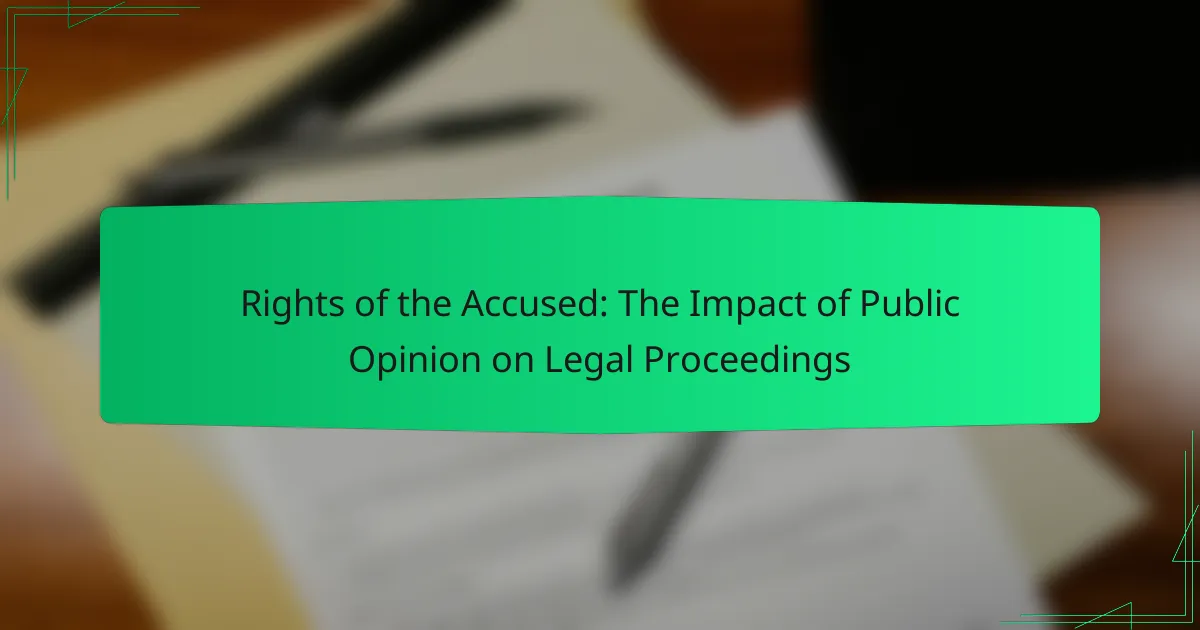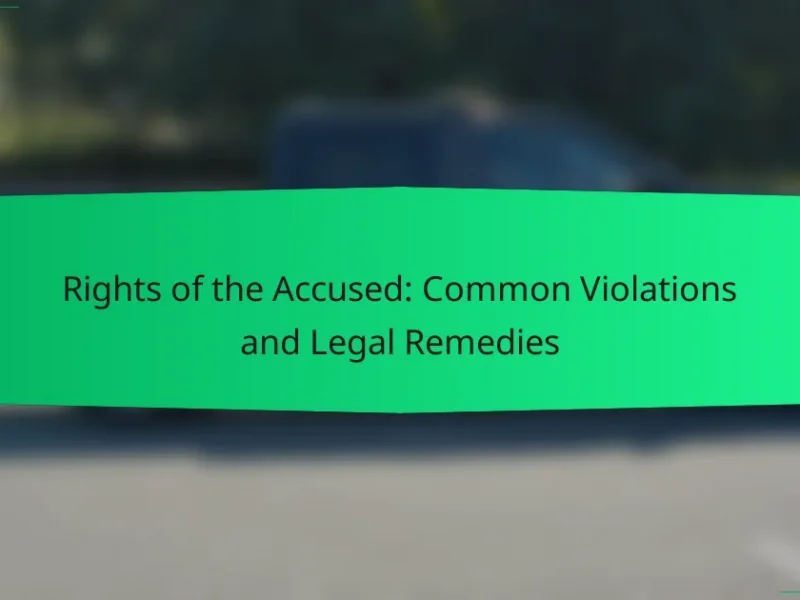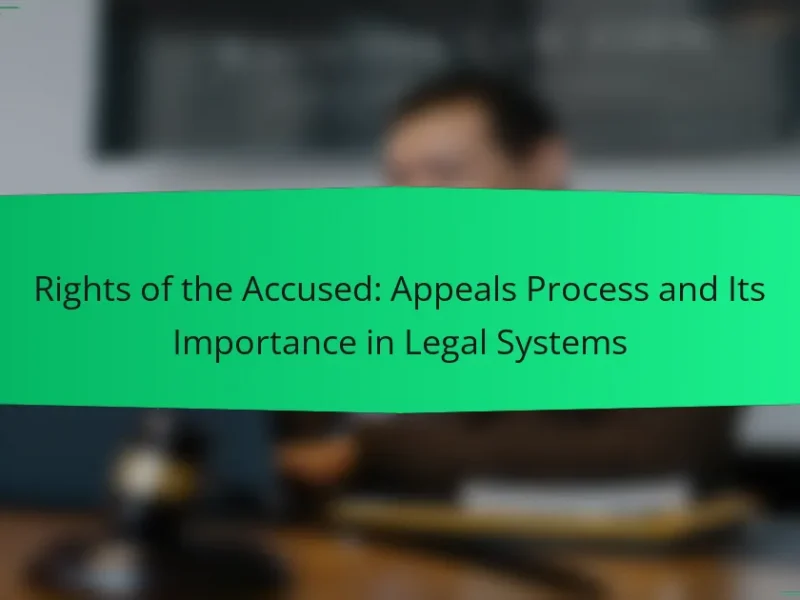The article focuses on the rights of the accused, which include the presumption of innocence, the right to a fair trial, and the right to legal counsel, as protected by the Sixth Amendment of the U.S. Constitution. It highlights the significant influence of public opinion on legal proceedings, noting how media coverage and social media can create bias against the accused, potentially leading to unfair trials and wrongful convictions. The discussion includes historical cases, such as Gideon v. Wainwright, and examines contemporary challenges, such as inadequate legal representation and overcrowded court systems, which can undermine the fundamental rights guaranteed to individuals within the legal framework.
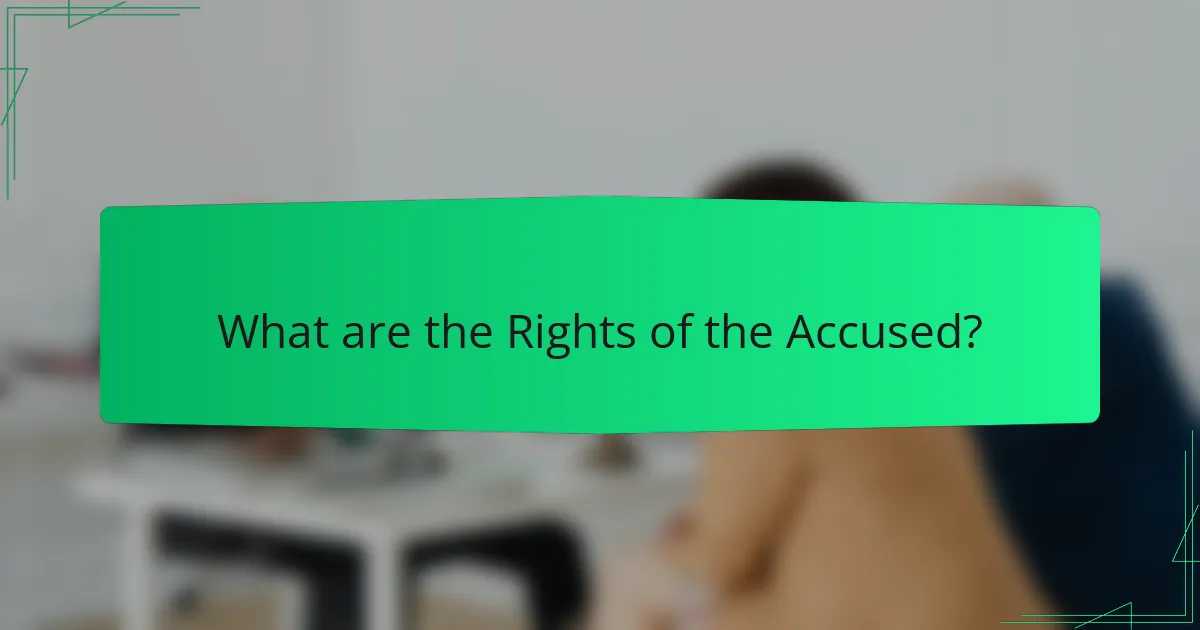
What are the Rights of the Accused?
The rights of the accused include the presumption of innocence, the right to a fair trial, and the right to legal counsel. The presumption of innocence means that an individual is considered innocent until proven guilty. A fair trial ensures that the accused has an impartial jury and the opportunity to present their case. The right to legal counsel allows the accused to have an attorney represent them during legal proceedings. These rights are protected under the Sixth Amendment of the U.S. Constitution. They are fundamental to ensuring justice and preventing wrongful convictions. Historical cases, such as Gideon v. Wainwright, underscore the importance of these rights in the legal system.
Why are the Rights of the Accused important in legal proceedings?
The Rights of the Accused are crucial in legal proceedings to ensure a fair trial. These rights protect individuals from wrongful convictions and abuse of power. They guarantee that the accused have access to legal representation. This access helps to level the playing field against the state. Furthermore, these rights uphold the presumption of innocence until proven guilty. Historical cases, such as Gideon v. Wainwright, established the necessity of legal counsel. This case demonstrated that without proper representation, justice cannot be served. Ensuring the Rights of the Accused fosters public confidence in the legal system. This confidence is essential for maintaining social order and trust in law enforcement.
What specific rights are guaranteed to the accused?
The accused are guaranteed specific rights under the law. These rights include the right to a fair trial, the right to remain silent, and the right to legal counsel. The Sixth Amendment of the U.S. Constitution ensures the right to a speedy and public trial. Additionally, the accused have the right to confront witnesses and to obtain witnesses in their favor. The Fourteenth Amendment provides protection against double jeopardy and ensures due process. These rights are fundamental to prevent wrongful convictions and protect individual freedoms.
How do these rights protect individuals during trials?
These rights protect individuals during trials by ensuring fair treatment and due process. They provide the accused with the right to legal representation, which is crucial for navigating complex legal systems. Rights such as the presumption of innocence prevent wrongful convictions by placing the burden of proof on the prosecution. Additionally, the right to a public trial safeguards against secret proceedings that could lead to bias or injustice. These protections are grounded in legal frameworks, such as the Sixth Amendment in the U.S. Constitution, which guarantees the accused a fair trial. Historical cases, like Gideon v. Wainwright, demonstrate the importance of these rights in securing justice for individuals.
How do public opinions influence the Rights of the Accused?
Public opinions significantly influence the Rights of the Accused by shaping legal standards and practices. When public sentiment is strong, it can lead to changes in laws and policies regarding the treatment of accused individuals. For instance, high-profile cases often result in public outcry, prompting lawmakers to reconsider existing rights and protections. This can manifest in increased scrutiny of legal procedures that might infringe on the rights of the accused. Additionally, media coverage can sway public opinion, creating pressure on legal systems to act in accordance with societal expectations. Historical examples, such as the public response to wrongful convictions, show how advocacy can lead to reforms that enhance the rights of the accused. Ultimately, public opinion acts as a catalyst for change, impacting the legal landscape surrounding accused individuals.
What role does media play in shaping public perceptions of accused individuals?
Media significantly influences public perceptions of accused individuals. It shapes narratives through coverage, framing, and tone. Sensationalized reporting can lead to bias against the accused. Studies show that negative portrayals increase public hostility. For example, a 2018 study by the American Psychological Association found that media framing affects juror decision-making. Media can also perpetuate stereotypes, impacting societal attitudes. Public opinion often sways legal proceedings, affecting jury selections and trial outcomes. Thus, media plays a crucial role in the perception of accused individuals.
How can public opinion impact the legal process and outcomes?
Public opinion can significantly impact the legal process and outcomes. It shapes perceptions of justice and influences decision-making among lawmakers and judges. High-profile cases often see public sentiment sway the legal proceedings. For example, public outcry can lead to increased media coverage, which can affect jury selection and trial outcomes. Research indicates that jurors may be influenced by prevailing public attitudes, potentially leading to biased verdicts. Additionally, public opinion can pressure authorities to pursue or drop charges, altering the trajectory of legal cases. Overall, the interplay between public opinion and the legal system underscores the importance of societal values in judicial outcomes.
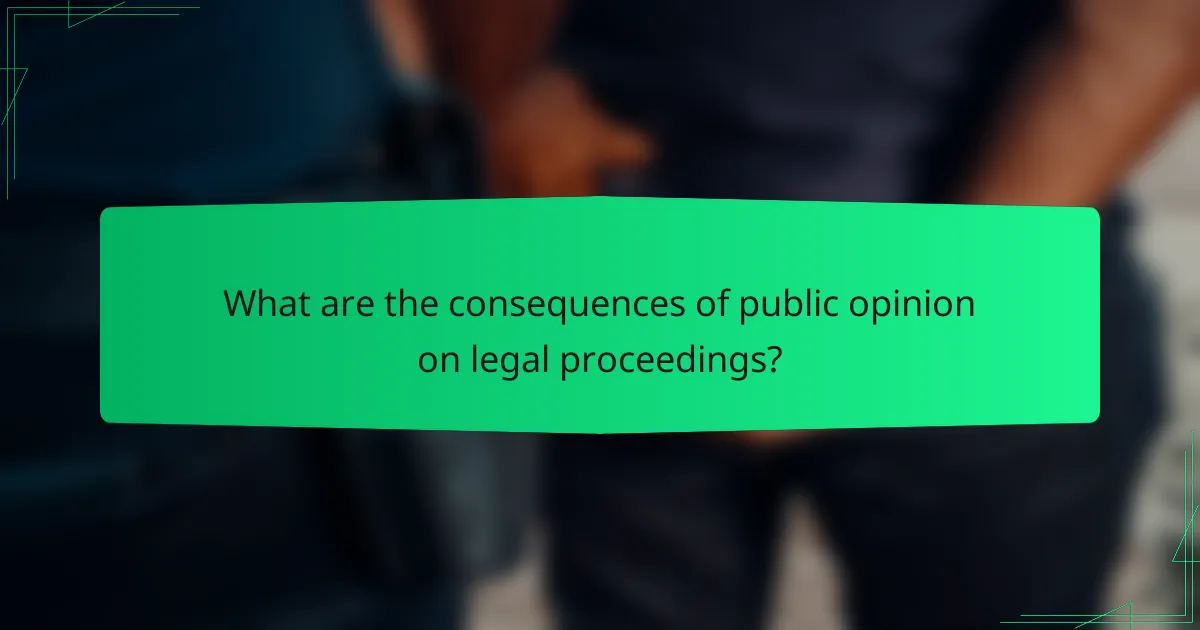
What are the consequences of public opinion on legal proceedings?
Public opinion can significantly influence legal proceedings. It may lead to jury bias, affecting impartiality. When jurors are exposed to public sentiment, their judgments can be swayed. This can result in unfair trials and wrongful convictions. High-profile cases often see intense media coverage, shaping public perception. Research indicates that pre-trial publicity can alter jurors’ views. Additionally, public opinion can pressure legal authorities to act in specific ways. For instance, prosecutors may feel compelled to pursue harsher charges due to public outcry. Ultimately, these dynamics can undermine the fairness of the judicial process.
How does public opinion affect jury decisions?
Public opinion can significantly influence jury decisions. Jurors may feel pressure to align their verdicts with community sentiments. This alignment can lead to biased decision-making, especially in high-profile cases. Research shows that jurors are aware of media coverage and public discourse surrounding cases. For instance, a study by the American Psychological Association found that jurors exposed to strong public opinion may alter their judgments to avoid social backlash. Additionally, jurors may discuss public sentiment during deliberations, further impacting their decisions. Overall, public opinion can create a context where jurors prioritize societal expectations over impartiality.
What are the implications of biased juries on trial outcomes?
Biased juries can significantly alter trial outcomes. They may lead to unfair verdicts that do not reflect the evidence presented. Bias can stem from pre-existing opinions, stereotypes, or external influences. This can result in wrongful convictions or acquittals. Studies show that jurors’ backgrounds and beliefs impact their decision-making processes. For instance, a 2012 study by the National Center for State Courts found that jurors with strong biases were less likely to follow the law. Consequently, biased juries undermine the integrity of the judicial system. They erode public trust in legal proceedings and can perpetuate systemic injustices.
How can jurors be shielded from public opinion?
Jurors can be shielded from public opinion through measures such as sequestration and careful jury selection. Sequestration involves isolating jurors from outside influences during a trial. This prevents exposure to media coverage and public discussions about the case. Jury selection processes can include questioning potential jurors about their biases. This helps ensure that jurors can remain impartial. Courts may also issue gag orders to limit public commentary on ongoing cases. These measures aim to uphold the integrity of the judicial process. Research indicates that these practices can significantly reduce the impact of public opinion on jurors’ decisions.
What measures are in place to protect the Rights of the Accused amidst public scrutiny?
The rights of the accused are protected through various legal measures. These include the presumption of innocence, which mandates that individuals are considered innocent until proven guilty. The right to a fair trial is essential, ensuring that the accused receives an impartial hearing. Legal representation is guaranteed, allowing the accused to have an attorney defend their case. Additionally, laws against prejudicial media coverage help mitigate public influence on judicial processes. Courts may impose gag orders to limit public statements by involved parties. These measures aim to uphold justice and protect the integrity of legal proceedings.
How do courts ensure fair trials despite public sentiment?
Courts ensure fair trials despite public sentiment by implementing strict legal procedures and safeguards. These include jury selection processes designed to eliminate bias. Judges may sequester juries to limit exposure to public opinion. They also provide instructions to jurors to focus solely on evidence presented in court. Courts can change the venue of a trial to mitigate local bias. Additionally, legal representation is guaranteed, ensuring that defendants have a fair chance to present their case. The presumption of innocence is a fundamental principle upheld throughout the trial process. These measures collectively help maintain the integrity of the judicial system in the face of public sentiment.
What legal remedies exist for violations of the Rights of the Accused?
Legal remedies for violations of the Rights of the Accused include suppression of evidence, dismissal of charges, and appeals. Suppression of evidence occurs when unlawfully obtained evidence cannot be used in court. Dismissal of charges can happen if the prosecution fails to uphold the rights of the accused. Appeals allow defendants to challenge convictions based on rights violations. These remedies are essential for ensuring fair trials and upholding justice. Courts often rely on precedents to enforce these remedies, such as the exclusionary rule established in Mapp v. Ohio.
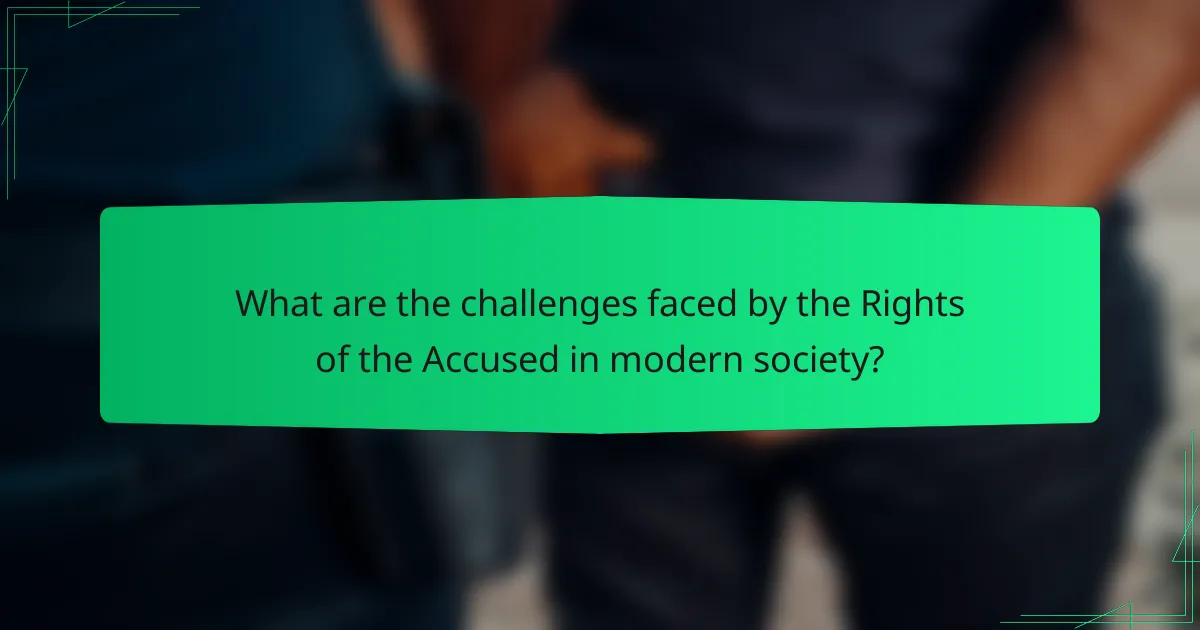
What are the challenges faced by the Rights of the Accused in modern society?
The challenges faced by the Rights of the Accused in modern society include public opinion influencing legal proceedings. Media coverage can create bias against the accused before a trial begins. This can lead to a presumption of guilt rather than innocence. Additionally, social media amplifies negative perceptions, affecting jury impartiality. Legal representation may be inadequate due to financial constraints. Overcrowded court systems can delay justice, impacting the accused’s rights. Furthermore, laws may not always protect the accused from unlawful searches or seizures. These factors collectively undermine the fundamental rights guaranteed to individuals within the legal system.
What are the emerging trends in public opinion regarding accused individuals?
Emerging trends in public opinion regarding accused individuals include increasing skepticism towards the justice system. Many people now question the fairness of trials and the presumption of innocence. This shift is influenced by high-profile cases and social media discussions. There is a growing demand for transparency in legal processes. Additionally, public sentiment often favors rehabilitation over punishment for non-violent offenders. Recent surveys indicate that younger demographics are more supportive of these views. Research shows that public opinion can significantly impact jury decisions and trial outcomes. As a result, the rights of the accused are increasingly being debated in light of societal attitudes.
How does social media impact the perception of accused persons?
Social media significantly influences the perception of accused persons. It shapes public opinion rapidly and broadly. Information, whether accurate or misleading, spreads quickly across platforms. This can lead to immediate judgment from the public. Studies show that negative portrayals can result in a presumption of guilt. The perception can affect jury selection and trial outcomes. In some cases, social media can even lead to mob mentality. This creates a challenging environment for fair legal proceedings.
What challenges do legal systems face in addressing public opinion?
Legal systems face significant challenges in addressing public opinion. One challenge is the potential for biased juries influenced by media coverage. Studies show that pre-trial publicity can shape jurors’ perceptions and decisions. Another challenge is the pressure on legal authorities to respond to public sentiment. This pressure can lead to hasty legal actions that compromise due process. Additionally, legal systems must balance public safety concerns with individual rights. This balance is crucial in maintaining justice while addressing community fears. Lastly, evolving public opinions can complicate the interpretation of laws. Legal systems often struggle to adapt to these changing societal values while ensuring fairness and equity.
What best practices can be adopted to uphold the Rights of the Accused?
Upholding the Rights of the Accused requires several best practices. First, ensure access to legal representation. This is fundamental for a fair trial. Second, maintain the presumption of innocence until proven guilty. This principle protects against wrongful conviction. Third, provide transparency in legal proceedings. Transparency fosters public trust and accountability. Fourth, educate law enforcement on the rights of the accused. Proper training helps prevent violations. Fifth, implement strict guidelines for media reporting on ongoing cases. This minimizes prejudicial influence on public opinion. Lastly, establish independent oversight bodies. These bodies can address complaints regarding rights violations effectively. Each of these practices contributes to a fair legal system and protects the rights of individuals.
How can legal professionals balance public opinion with ethical obligations?
Legal professionals can balance public opinion with ethical obligations by adhering to established legal ethics and prioritizing their duty to the client. They must ensure that their actions do not compromise the fair trial rights of the accused. Legal ethics, as defined by organizations such as the American Bar Association, emphasize the importance of confidentiality and loyalty to clients.
Public opinion may influence perceptions, but legal professionals are bound to uphold justice and the rule of law. They can engage in public education to clarify legal processes and mitigate misconceptions. Additionally, legal professionals should avoid commenting on ongoing cases in public forums to prevent prejudicing the proceedings.
By focusing on ethical standards and maintaining professional integrity, legal professionals can navigate the complexities of public opinion while fulfilling their obligations to their clients and the legal system.
What strategies can be employed to educate the public on the Rights of the Accused?
Public education on the Rights of the Accused can be achieved through various strategies. First, community workshops can provide interactive learning experiences. These workshops can cover legal rights, procedures, and case studies. Second, informative campaigns using social media can reach a wider audience. These campaigns can share infographics and videos explaining rights clearly. Third, partnerships with local organizations can facilitate outreach programs. These programs can target schools and community centers for presentations. Fourth, distribution of printed materials can further reinforce knowledge. Brochures and pamphlets can summarize key rights and provide resources. Fifth, engaging legal professionals as speakers can enhance credibility. Their expertise can offer insights and answer public questions. Lastly, incorporating real-life case studies can illustrate the importance of these rights. This approach can make the information relatable and impactful.
The main entity of the article is the “Rights of the Accused,” which are fundamental legal protections guaranteed to individuals facing criminal charges. The article examines how public opinion influences these rights and the legal proceedings surrounding them, highlighting the presumption of innocence, the right to a fair trial, and the right to legal counsel as key components. It discusses the impact of media portrayal and societal attitudes on jury decisions and trial outcomes, as well as the challenges faced by the legal system in maintaining these rights amidst public scrutiny. Additionally, the article outlines best practices for upholding the Rights of the Accused and strategies for educating the public on these essential legal protections.
